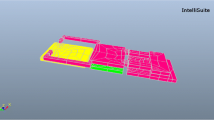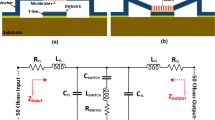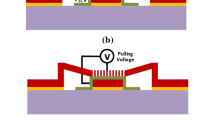Abstract
A simple structure, high-force and high isolation metal contact RF MEMS switch was fabricated based on micro electroplating technology, and the mechanical and RF performance of the switch were measured. After release and annealing, the switch’s cantilever beam showed a tip-up of less than 1 µm over the beam length of 485 µm, indicating a good stress control and thermal stability of the electroplated gold. The pull-in voltage and the switching characteristics at different temperatures, ranging from 25 to 90 °C, were investigated. A fast, stable and temperature independent switching process was observed as the actuation voltage was 10% larger than the pull-in voltage. Based on the classical cantilever beam model, both the electrostatic actuation force and the return force of the switch were larger than 1000 μN, and the extracted effective spring constant of the free-standing beam was 718 N/m. Cold RF tests were carried out at various temperatures by a network analyzer, and we found that temperature showed very less influence on the insertion and isolation of the switch in the present case. At 25 °C, the insertion loss was −0.13 dB at 10 GHz, and was lower than −0.3 dB over the 0.05−20 GHz frequency range. The isolation was −36 dB at 10 GHz, and was higher than −27 dB over the entire scanning frequency range. The high isolation performance is consistent with a lumped-element equivalent circuit analysis of the switch.










Similar content being viewed by others
References
Alcheikh N, Xavier P, Duchamp JM, Schuster KF, Malhaire C, Remaki B, Boucher C, Mescot X (2014) Temperature dependence of the electromechanical characteristics of superconducting RF-MEMS switches. Microsyst Technol 21:1–7
Chiou JC, Chou LC, Lai YL, Huang SC (2012) A novel thermal switch and variable capacitance implement by CMOS MEMS process approaching in micro electrostatic converter. Solid State Electron 77:56–63
Deng PG, Lee YK, Lin R, Zhang TY (2012) Nonlinear electro-mechanobiological behavior of cell membrane during electroporation. Appl Phys Lett 10:053702
Deng PG, Lee YK, Zhang TY (2014) A nonlinear electromechanical coupling model for electropore expansion in cell electroporation. J Phys D Appl Phys 47:445401–445411
Gilbert KW, Mall S, Leedy KD, Crawford B (2008) A nanoindenter based method for studying MEMS contact switch microcontacts. In: Proceedings of the 54th IEEE holm conference on electrical contacts 2008, pp 137–144
Jaafar H, Beh KS, Yunus NAM, Hasan WZW, Shafie S, Sidek O (2014) A comprehensive study on RF MEMS switch. Microsyst Technol 20:2109–2121
Jan MT, Hamid NHB, Khir MHM, Ashraf K, Shoaib M (2014) Reliability and fatigue analysis in cantilever-based mems devices operating in harsh environments. J Qual Reliab Eng. doi:10.1155/2014/987847
Jang Y, Kang S, Kim HC, Chun K (2011) An RF MEMS switch with a differential gap between electrodes for high isolation and low voltage operation. J Micromech Microeng 21:75016–75024
Lii LR, Murphy KD (2010) Impact dynamics of MEMS switches. Nonlinear Dynam 60:327–339
Mafinejad Y, Zarghami M, Kouzani AZ (2013) Design and simulation of high isolation RF MEMS shunt capacitor switch for C–K band. Ieice Electron Expr 10:2347–2351
Mercado LL, Koo SM, Lee TYT, Liu L (2003) A mechanical approach to overcome RF MEMS switch stiction problem. In: IEEE electronic components and technology conf. 2003, pp 377–384
Mulloni V, Lorenzelli L, Margesin B, Barbato M, Meneghesso G (2016) Temperature as an accelerating factor for lifetime estimation of RF-MEMS switches. Microelectron Eng 160:63–67
Muniraj NJR, Sathesh K (2011) Design of MEMS switch for RF applications. Microsyst Technol 17:161–163
Newman HS, Ebel JL, Judy D, Maciel J (2008) Lifetime measurements on a high-reliability RF-MEMS contact switch. IEEE Microw Wireless Compon Lett 18:100–102
Oberhammer J, Stemme G (2006) Active opening force and passive contact force electrostatic switches for soft metal contact materials. J Microelectromech Syst 15:1235–1242
Pamidighantam S, Puers R, Baert K, Tilmans HAC (2002) Pull-in voltage analysis of electrostatically actuated beam structures with fixed-fixed and fixed-free end conditions. J Micromech Microeng 12:458–464
Pirmoradi E, Mirzajani H, Ghavifekr HB (2015) Design and simulation of a novel electro-thermally actuated lateral RF MEMS latching switch for low power applications. Microsyst Technol 21:465–475
Pisheh HS, Kim JM, Rebeiz GM (2009) A novel stress-gradient-robust metal-contact switch. IEEE MEMS 2009:27–30
Rebeiz GM (2003) RF MEMS: theory, design, and technology. Wiley, New York
Schimkat J (1999) Contact measurement providing basic design data for microrelay actuators. Sens Actuators A Phys 73(1–2):138–143
Shankar D, Mohd I, Ramjay P, Jain KK, Chatterjee R (2011) Effect of residual stress on RF MEMS switch. Microsyst Technol 17:1739–1745
Sim SM, Lee Y, Jang YH, Lee YS, Kim YK, Ignacio LG, Kim JM (2016) A 50–100 GHz ohmic contact SPDT RF MEMS silicon switch with dual axis movement. Microelectron Eng 162:69–74
Toler BF, Coutu RA, Mcbride JW (2013) A review of micro-contact physics for microelectromechanical systems metal contact switches. J Micromech Microeng. doi:10.1088/0960-1317/23/10/103001
Yuan XL, Huang QA, Liao XP (2008) Analysis of electromagnetic interference of a capacitive RF MEMS switch during switching. Microsyst Technol 14:349–360
Acknowledgements
This work was supported by the CRSRI Open Research Program (Grant No. CKWV2014225/KY), the Wuhan Science and Technology Bureau Grant (Grant No. 2015010101010002), the National Young 1000 Talents Plan, the Young 1000 Talents Plan of Sichuan province.
Author information
Authors and Affiliations
Corresponding author
Rights and permissions
About this article
Cite this article
Deng, P., Wang, N., Cai, F. et al. A high-force and high isolation metal-contact RF MEMS switch. Microsyst Technol 23, 4699–4708 (2017). https://doi.org/10.1007/s00542-017-3302-3
Received:
Accepted:
Published:
Issue Date:
DOI: https://doi.org/10.1007/s00542-017-3302-3




